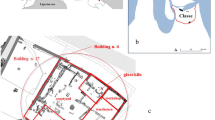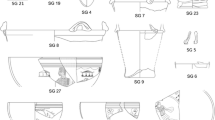Abstract
The concentrations of Na, Mg, Al, Si, S, Cl, K, Ca, Ti, Mn, Fe, Ni, Cu, Zn, Br, Sr, Zr, Sn, Sb and Pb in 40 archaeological glasses from the Early Byzantine Jelica site in Serbia, are determined by PIXE/PIGE. Geochemical and multivariate analysis shows it corresponds to Foy series 2.1 and 3.2. Regionally, it is similar to the contemporary 6th century composition from Lower Danube (Bulgaria), Caričin Grad (Serbia) and Butrint (Albania). The results indicate that trade routes between these inland regions and the rest of the Empire were mostly open even during turbulent times of the 6th century.









Similar content being viewed by others
Change history
03 September 2018
The affiliation of the first author was incorrectly published in the original article. The author’s correct affiliation is given in this correction.
References
Sayre EV, Smith RW (1961) Compositional categories of ancient glass. Science 133:1824–1826
Brill RH (1988) Scientific investigations of Jalame glass and related finds. In: Weinberg GD (ed) Excavations in Jalame: site of a glass factory in Late Roman Palestine. University of Missouri, Columbia, pp 257–294
Henderson J (2002) Tradition and experiment in first millennium A.D. glass productions and the emergence of Early Islamic glass technology in Late Antiquity. Acc Chem Res 35:594–602
Mirti P, Casoli A, Appolonia L (1993) Scientific analysis of Roman glass from Augusta Praetoria. Archeomotry 35:225–240
Freestone IC (1994) Appendix: chemical analysis of ‘raw’ glass fragments. In: Hurst HR (ed) Excavations at Carthage, vol II, 1. The circular harbour, North Side. The site and finds other that pottery. British Academy Monographs in Archeology, No. 4. Oxford University Press, Oxford, p 290
Foster H, Jackson C (2009) The composition of ‘naturally coloured’ late Roman vessel glass from Britain and the implications for models of glass production and supply. J Archeol Sci 36:189–204
Freestone IC, Wolf S, Thirlwall M (2005) The production of HIMT glass: elemental and isotopic evidence. In: Annales du 16e Congrès de l’Association Internationale pour l’Histoire du Verre. London, UK, 2003, AIHV, Nottingham, pp 153–157
Freestone IC, Gorin-Rosen MY, Hughes MJ (2000) Primary glass from Israel and the production of glass in Late Antiquity and the Early Islamic Period. La Route du verre, Lyon, pp 65–83
Gratuze B, Barrandon JN (1990) Islamic glass weights and stamps: analysis using nuclear techniques. Archaeometry 32(2):155–162
Foy D, Picon M, Vichy M, Thirion-Merle V (2003) Caractérisation des verres de la fin de l’Antiquité en Méditerranée occidentale: l’émergence de nouveaux courants commerciaux. In: Mergoil M (Ed) Échanges et commerce du verre dans le monde Antique, Aix-en-Provence et Marseiile, Montagnac, (Monographies Instrumentum 24), pp 41–86
Phelps M, Freestone IC, Gorin-Rosen Y, Gratuze B (2016) Natron glass production and supply in the late antique and early medieval Near East: the effect of the Byzantine-Islamic transition. J Archeol Sci 75:57–71
Foy D, Vichy M, Picon M (2000) Lingots de verre en Mediterranee occidentale (IIIe siècle av. J.-C.—VIIe siècle ap. J.-C.). In: Annales du 14e Congrès de l’Association Internationale pour l’Historie du Verre, Italia/Venezia–Milano, 27 October–1 November 1998, 51–7, AIHV, Lochem
Rehren T, Freestone I (2014) Pattern in glass use in the Roman and Byzantine worlds: a reports on current research at the institute of archeology and UCL Qatar. Archeol Int 17:74–78
Rehren T, Cholakova A (2010) The early HIMT glass from Dichin, Northern Bulgaria, UCL. Interdiscip Stud 22–23:81–96
Cholakova A, Rehren T, Freestone I (2015) Compositional identification of 6th c. AD glass from the Lower Danube. J Archaeol Sci Rep 7:625–632. https://doi.org/10.1016/j.jasrep.2015.08.009
Smith T, Henderson J, Faber EW (2016) Chapter 11: Early Byzantine glass supply and consumption: the case of Dichin, Bulgaria. In: Gan F, Li Q, Henderson J (eds) Recent advances in the scientific research on ancient glass and glaze. Series on archaeology and history of science in China, vol 2. World Scientific, Singapore
Drauschke J, Greiff S (2010) Early Byzantine glass from Caričin Grad/Iustiniana Prima (Serbia): first results concerning the composition of raw glass chunks. In: Zorn B, Hilgner A (eds) Glass along the silk road from 2000 BC to AD 1000. Verlag des Römisch-Germanischen Zentralmuseums, Mainz, pp 53–67
Ivanišević V, Stamenković S, (with a contribution by Greiff S) (2010) » Glass « Workshop from Caričin Grad (Iustiniana Prima). In: Zorn B, Hilgner A (eds) Glass along the Silk Road from 200 BC to AD 1000. RGZM, Mainz
Stojanović MM, Šmit Ž, Glumac M, Mutić J (2015) PIXE–PIGE investigation of Roman Imperial vessels and window glass from Mt. Kosmaj, Serbia (Moesia Superior). J Archaeol Sci Rep 1:53–63
Stamenković S (2009) Kasnoantičko staklo sa Gradine u Vrsenicama. In: Popović M, Bikić V (eds) Vrsenice, Late Roman and Serbian Early Medieval Fortress. Arheološki Institut, Beograd
Križanac M, Mrkobrad D (2012) Кacнoaнтичкo и paнoвизaнтиjcкo cтaклo ca Гpaдинe y Постењу (Late antique and early Byzantine glass from Gradina in Postenje). Збopник н.c./Zbornik n.s. 08/2012 (Beograd), Muzej primenjene umetnosti, pp 7–22
Križanac M (2015) 5th-6th century glass in Serbia and territory of Kosovo. In: Lazar I (ed) Annales du 19e Congrès de L’association internationale pour l’histoire du verre (Piran, 17th–21st September 2012), Koper, pp 337–349
Križanac M (2009) Glass from Early Byzantine Gradina on Mount Jelica (Serbia). In: Ergün L (ed) Late Antique/Early Byzantine glass in the Eastern Mediterranean. Hürriyet Matbaası, Izmir
Lightfoot C (2007) Trade and industry in Byzantine Anatolia: the evidence from Amorium, vol 61. DumbartON, Oaks Papers, Dumbarton Oaks, Washington D.C., pp 269–286
Šmit Ž, Milavec T, Fajfar H, Rehren T, Lankton JW, Gratuze B (2013) Analysis of glass from the post-Roman settlement Tonovcov grad (Slovenia) by PIXE–PIGE and LA-ICP-MS. Nucl Instrum Methods Phys Res B 311:53–59
Gómez-Tubío B, Ontalba Salamanca MÁ, Ortega’Feliu I, Respaldiza MÁ, Amores Carredano F, Gonzáles’Acuña D (2006) PIXE–PIGE analysis of late roman glass fragments. Nucl Instrum Methods Phys Res B 249:616–621
Tamilarasu S, Velraj G, Ray DK, Acharya R (2016) Chemical analysis of archaeological clay potteries by PIGE and PIXE methods using proton beams from tandem accelerator for provenance study. J Radioanal Nucl Chem 310:363–370
Bro R, Smilde AK (2003) Centering and scaling in component analysis. J Chemom 17:16–33
Schreurs JWH, Brill RH (1984) Iron and sulfur related colors in ancient glasses. Archaeometry 26(pt. 2):199–209
Wedepohl KH, Simon K, Kronz A (2011) Data on 61 chemical elements for the characterization of three major glass compositions in late antiquity and the middle ages. Archaeometry 53:81–102
Jackson CM (2005) Making colourless glass in the Roman period. Archeometry 47(4):763–780
Gorin-Rosen Y (2000) The ancient glass industry in Israel: summary of the finds and new discoveries, La Route du verre. Ateliers primaires et secondaires du second millénaire av. J.-C. au Moyen Âge. Colloque organisé en 1989 par l’Association française pour l’Archéologie du Verre (AFAV). Maison de l’Orient et de la Méditerranée Jean Pouilloux, Lyon, pp 49–63
Al-Bashaireh K, Al-Mustafa S, Freestone IC, Al-Housan AQ (2016) Composition of Byzantine glasses from Umm el-Jimal, northeast Jordan: insights into glass origins and recycling. J Cult Herit 21:809–818
Foy D, Picon M (2005) L’origine du verre en Méditerranée occidentale à la fin de l’Antiquité et dans la haut Moyen Âge, La Méditerranée et le monde mèrovingien: tèmoins archèologiques BAP. Supplèment 3, Èditions de l’ APA, pp 99–110
Nenna M-D, Vichy M, Picon M (1997) L’Atelier de Verrier de Lyon du 1er Siècle après J.-C., et l’Origine des Verre “Romains”. Revue d’Archaéométrie 21:81–87
Gliozzo E, Turchiano M, Giannetti F, Santagostino BA (2015) Late Antique glass vessels and production indicators from the town of Herdonia (Foggia, Italy): new data on CaO-rich/weak HIMT glass. Archaeometry. https://doi.org/10.1111/arcm.12219 (in press)
Gliozzo E, Lepri B, Saguì L, Turbanti Memmi I (2015) Colourless glass from the Palatine and Esquiline hills in Rome (Italy): New data on antimony- and manganese-decoloured glass in the Roman period. J Archaeol Anthropol Sci. https://doi.org/10.1007/s12520-015-0264-1
Schibille N, Sterrett-Krause A, Freestone IC (2017) Glass groups, glass supply and recycling in late Roman Carthage. Archeol Antrhropol Sci 9:1223–1241. https://doi.org/10.1007/s12520-016-0316-1
Conte S, Chinni T, Arletti R, Vandini M (2014) Butrint (Albania) between eastern and western Mediterranean glass production: EMPA and LA-ICP-MS of late antique and early medieval finds. J Archaeol Sci 49:6–20
Freestone IC (2006) Glass production in late antiquity and the early Islamic period: a geochemical perspective. In: Maggetti M, Messiga B (eds) Geomaterials in cultural heritage. Geological Society, London, pp 201–216 (special publication 257)
Freestone I, Degryse P, Lankton J, Gratuze B, Schneider J (2018) HIMT, glass composition and commodity branding in the primary glass industry. In: Rosenow D, Phelps M, Meek A, Freestone I (eds) Things that travelled, Mediterranean glass in the first millenium CE. UCL Press, London, pp 159–190
Ceglia A, Cosyns P, Nys K, Terryn H, Thienpont H, Meulebroeck W (2015) Late antique glass distribution and consumption in Cyprus: a chemical study. J Archaeol Sci 61:213–222
Acknowledgements
Roman Balvanović acknowledges the support by the Ministry of Education, Science and Technological Development of Serbia through project “Physics and Chemistry with Ion Beams”, No. III45006; the work of Žiga Šmit is supported by the Slovenian Research Agency (research core Funding No. P6-0283). The analyzed samples are from the excavations of the Jelica-Gradina site, a project of the Faculty of Philosophy, University of Belgrade, supported by the Ministry of Culture and Information of Serbia through the Project No. 177012, under the direction of Mihailo Milinković, to whom authors kindly thank for the valuable information about the site. The samples are kindly provided by National Museum Čačak. Photographs: Veljko Ilić, National Museum Belgrade.
Author information
Authors and Affiliations
Corresponding author
Appendices
Rights and permissions
About this article
Cite this article
Balvanović, R., Stojanović, M.M. & Šmit, Ž. Exploring the unknown Balkans: Early Byzantine glass from Jelica Mt. in Serbia and its contemporary neighbours. J Radioanal Nucl Chem 317, 1175–1189 (2018). https://doi.org/10.1007/s10967-018-5987-x
Received:
Published:
Issue Date:
DOI: https://doi.org/10.1007/s10967-018-5987-x








